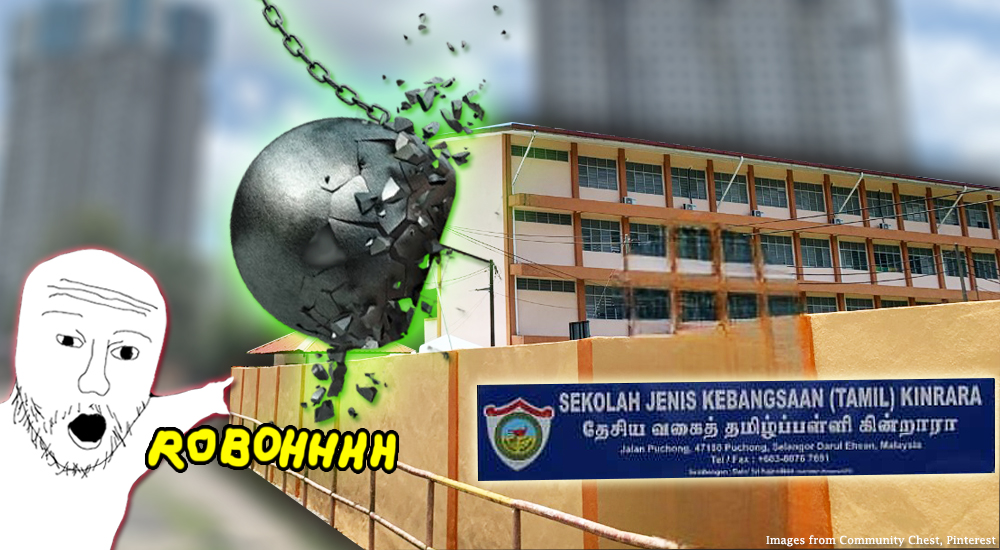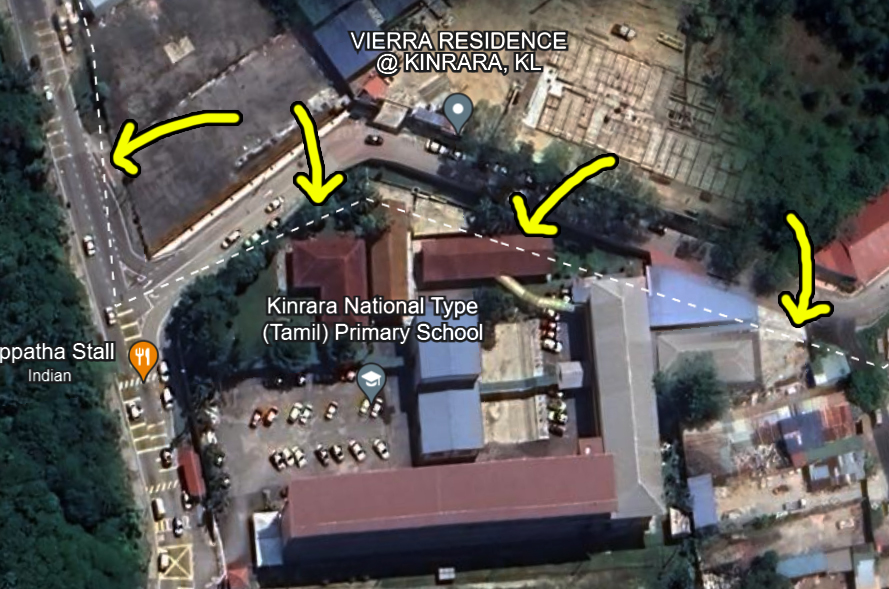Here’s how the government is causing issues for a Tamil primary school

- 866Shares
- Facebook247
- Twitter72
- LinkedIn72
- Email77
- WhatsApp398
At first glance, Puchong might not strike you as much. It’s got that rustic kampung charm and stores like Avon still holding on strong. But like many areas on the outskirts of KL, development has crept in. Behold Vierra Residence Kinrara, a looming high-rise complex that dwarfs SJKT Ladang Kinrara– the Tamil primary school next to it.

If the school name rings a bell, it’s probably because you’ve seen it in the news lately. The developers of Vierra Residence want to widen an existing road into their fancy complex, so they’ve asked the school to tear down a chunk of its building. Well, that’s not exactly true. They didn’t ask— they simply handed the school a notice and a deadline.
It’s honestly alarming. Many parties were involved in the decision making process– including MPs, the developer, and even the Kuala Lumpur City Hall (DBKL)– yet the school was left out from a crucial meeting that led to this demolition notice. Suddenly, the MPs are saying they never actually approved that decision. But it’s only now when protests are happening that they’re scrambling to find a solution.
This whole situation just leaves a sour taste in the mouth. SJKT Ladang Kinrara caters to a large group of B40 students, many of whom depend on school for more than just learning– it’s their safe space. They should be able to feel secure and at ease in that environment. But it seems for all those in high places, the bigger concern is… traffic.
DBKL is bracing for a surge of cars due to Vierra Residence’s massive capacity
So the road at the centre of this debacle actually runs along the side and back of SJKT Ladang Kinrara, leading straight to the front gates of Vierra Residence. And in picture form, it’s the one shown in yellow:

The idea to widen the road came from DBKL themselves, probably due to the expected traffic from the residence’s 1600 units. Currently, it’s just a two-lane road. Originally, it was meant to be four lanes wide, which would have required the school to demolish several buildings, namely their canteen, music room, and kindergarten.

But after all the back-and-forth and the conflicts that have cropped up, DBKL had settled on a compromise: a three-lane wide road. While this would encroach on way less land, there’s a catch. You know how when you build next to a road, there’s something called a setback?
It’s like a buffer zone between the building and the building’s surrounding wall (think those tall barricades around apartments and schools). It’s an area that usually consists of drains and some land. In this scenario, if a setback is added after constructing the new wall for the 3-lane road, it might result in nearly the same impact as a 4-lane road.
That’s a lot to swallow, so here’s a TLDR: Whether it’s a 3-lane road or a 4-lane road, the impact on the school is still significant. But there’s another thing that complicates this situation even further.
SJKT Ladang Kinrara is located in part-Selangor and part-KL
Alright, let’s break this down. Do you see those dotted white lines on the map?

Well, they’re not just any random line, they’re actually there to mark the state boundaries. So here’s the situation: the brand-new apartment and the road are nestled comfortably in Wilayah Persekutuan. Meanwhile, the school is mainly in Selangor but stretches a little into KL territory.
Now, you might be wondering, how on earth did this happen?
Well, back in 1946, way before we had our independence and before KL became a federal territory, the school was already up and running. It wasn’t until 1974 that KL decided to split from Selangor and set up its own state lines. It just so happened that those lines cut too close to the school. And now here we are, years later, caught in this tussle.

Do these state lines mean that each state does its own thing without a clue about what’s happening on the other side? Honestly, we’re not entirely sure. But if that’s the case, it’s definitely something the authorities should look into. At any rate, it does shed light on why DBKL has been calling the shots regarding the road size, considering it’s pretty much land within their control.
Interestingly, Puchong itself is split into four different subdivisions. It falls under the purview of MBSJ (Subang Jaya), DBKL (Kuala Lumpur), MPSepang (Sepang), and MPKL (Kuala Langat). The school is located in Kinrara, which falls under MBSJ’s jurisdiction. Strangely enough, earlier reports suggest that even MBSJ wasn’t included in the meeting that allegedly approved the demolition.
At this point though, you might be curious about the developer of this project and what their stance is in all of this.
Fajarbaru offered SJKT Ladang Kinrara a measly RM50k in compensation
For those who don’t know, Fajarbaru is a real heavyweight in the construction game. Some of you might recognize them from their work on some of our LRT stations, the LCCT at Sepang, and their involvement in building Gleneagles Hospital in Ampang. Simply put, they’re a massive company (with probably loads of experience and deep pockets).

When the issue of demolition first came up, the school’s initial request was for Fajarbaru to reconstruct what they had to tear down. Specifically, they asked for a 3-storey building and a 2-storey canteen. Now, you might think a multi-level canteen is a bit of an overkill, but in reality, there isn’t much space on the school grounds, especially once the demolition shrinks it further. So, opting for a two-story canteen was really the school’s way of making the most out of limited space.
Fajarbaru wanted no part in that plan. Instead, they offered the school RM50,000 in general compensation.
To any Ali, Muthu or Ah Hock, that’s a huge amount. But let’s put that number into perspective. In 2021, a school in Kuching received RM50,000 to buy furniture and teaching aid. In 2023, the former Director General of JKR (the fellas who routinely build schools) said it would cost roughly RM90,000 to build a single classroom.
“The total cost for a classroom will currently be about RM 200 per square foot. So, now the total cost for a classroom [is] RM 90,000 (RM200 x 450 square feet/per classroom),”– excerpt from Newswav
So what can RM50,000 really do when faced with the absence of a canteen, kindergarten, and music room?
The convenience for residents means the kids will have nowhere to eat
As it stands right now, Fajarbaru wants the school’s land ASAP. In the notice they handed the school, the date mentioned was April 1st.

This poses an even greater dilemma because the sequence of events is not as straightforward as building the new school first and then demolishing the old part for the road. Instead, the road is planned to be constructed first, followed by the new school buildings. This raises several critical questions:
- Where will the students go in the meantime?
- Will they be squeezed into their half-demolished canteen or forced to eat in their classrooms?
- How long will this construction project drag on?
- How long must these kids cope with displacement?
Come to think of it, why didn’t the developers and local authorities consider alternative solutions, like relocating the entrance of the residence? And how was the project approved by DBKL in the first place, especially knowing that the road had to be widened where the school land is located? After all, it’s not like the school was built yesterday.
Unfortunately, these are questions that even the school has no answers to. And the authorities we reached out to haven’t addressed them either. But now that we’re on this topic, let’s address a more general concern.
What’s the government’s purpose, if not to look after the welfare of its people?
Right at the heart of it all, there’s a glaring lack of empathy from both the government and developers when it comes to dealing with the land they want to develop. And what’s worse, the law seems to back up this behavior.
Let’s talk about the Land Acquisition Act 1960. It essentially says your land can be taken for redevelopment, even if you’re totally against it. And this is exactly what’s happening right now at Kg. Sg. Baru. In short, the government is planning a major makeover for the town, and while most residents consented to give up their homes… some did not. It would seem their voices don’t really matter considering the government only needed 50% of the property owners to agree for the project to proceed. To which we say:
And then there’s the issue of new developments popping up in every corner. Just recently there was a protest among residents of Sierramas and Valencia against the construction of new service apartments in their area. They were worried if their one access road can handle the influx of traffic, not to mention the fact that these new apartments are planned on a hill slope. These concerns were brought to the local town council, and guess what their response was? 🦗🦗 (Nothing).
So here’s the million ringgit question–is the government, i.e. the ones responsible for approving these projects and overseeing city planning, truly fulfilling their duty to the people they’re supposed to serve?
Well, until we see an end to schools and residents protesting, you probably already know what the answer is.
- 866Shares
- Facebook247
- Twitter72
- LinkedIn72
- Email77
- WhatsApp398





